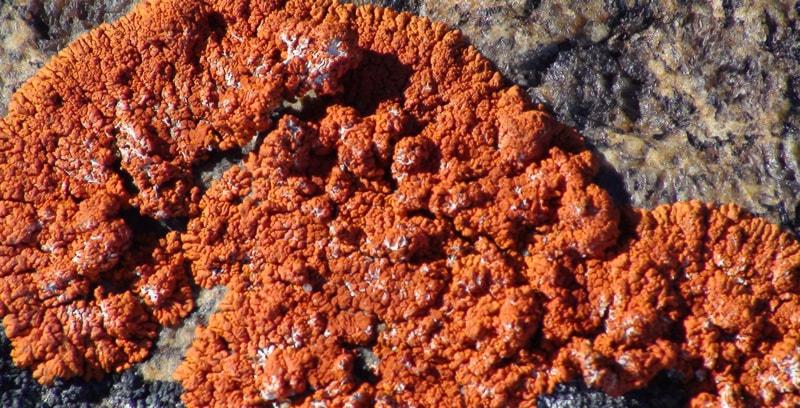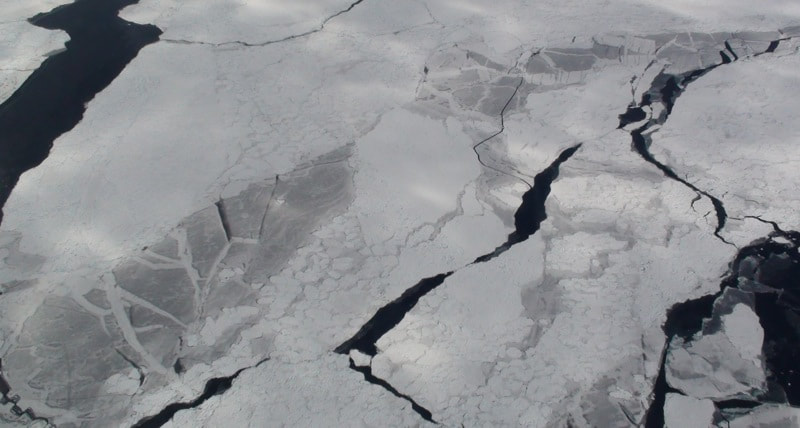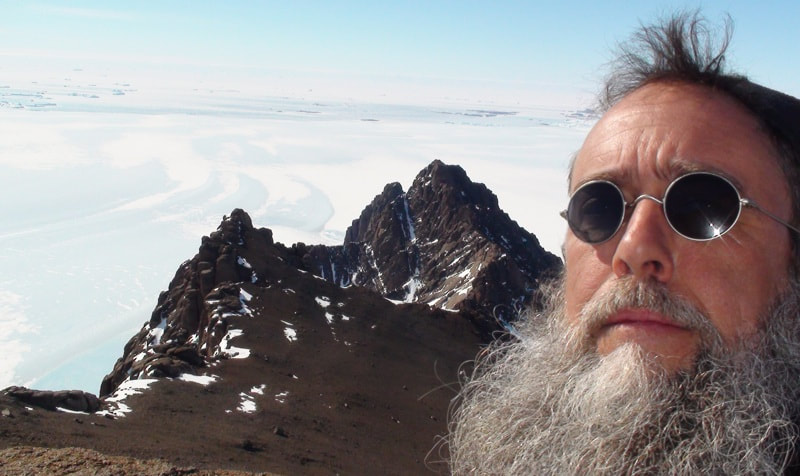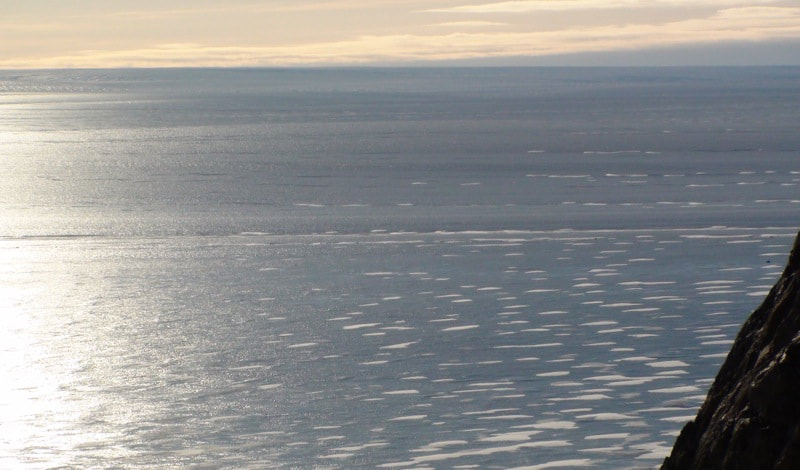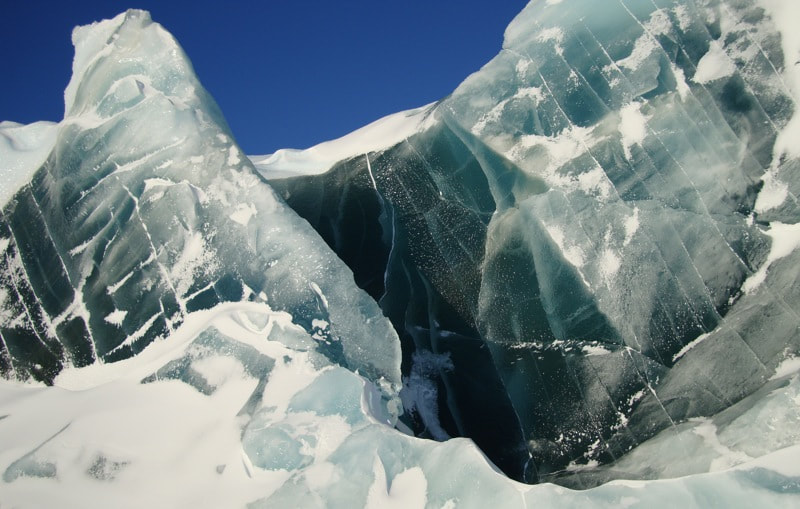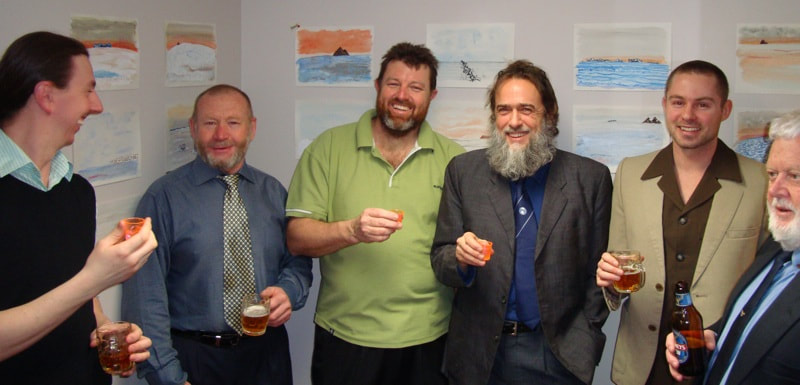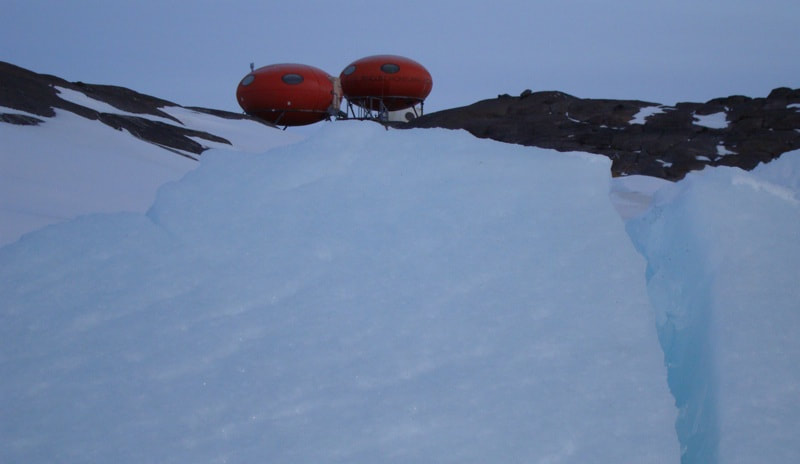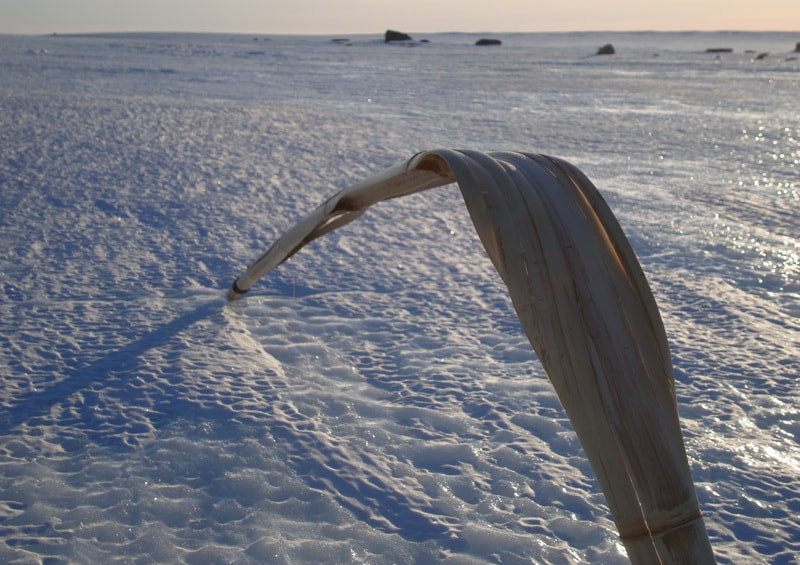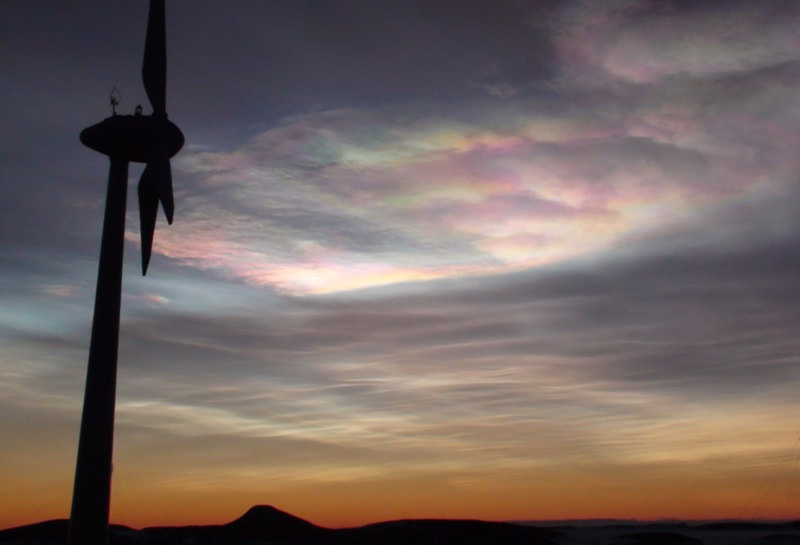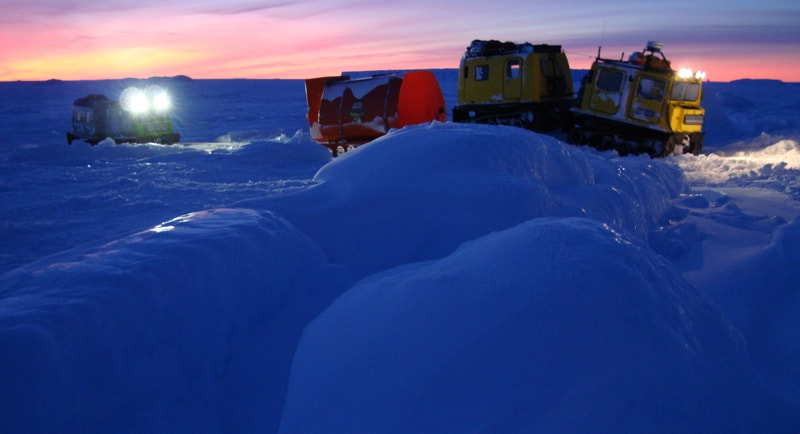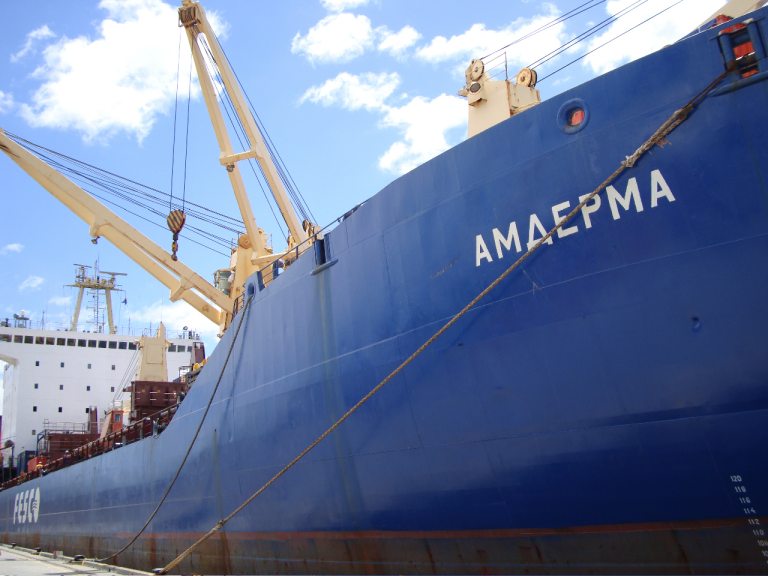|
I soon say good-bye to hut fever in its Antarctic form and prepare for other fevers. My immune system must be rather weak now after a year of no internal microscopic bug wars to keep it fit I also worry that my tolerance to other peoples concerns has been severely diminished as well. How can I pretend to be concerned or even bother listening to anyone who has trivial complaints or mentions topics like –Michael Jackson’s new film, fashion tips by the US president’s wife or which celebrity is doing naughty things. I have had little to do with many things for a long time, even important world news has seemed so faraway and unconnected to life here on the Ice that I may seem rather callous when I return. Maybe I was callous before I wintered? I hope I did not loose any empathy out there on that slippery icecap. I have been living in a tiny outpost of society that cannot survive at all without support from “home” but it is a fact that I feel very distant, fuzzy and maybe hesitant about re-integration into normal society. Everyone certainly misses their loved ones and I desire enormously to see Carolina but our concerns have been artificially limited due to the isolation. Concentration is elusive now as I slowly start to readjust for the welcome home onslaught. All these feelings sum up what is called “a burnt out winterer” or a “broken” winterer as an Argentinean Antarctic doctor tells me. I feel pretty weathered both internally and externally as I sit here and wait for the Casa light plane to land. Admittedly I did put myself in this situation and pushed myself with an intensive work routine. I may be drained more by my elongated self-inflicted studio time than the dark temporal oddity of an Antarctic winter. I wave goodbye to this far-flung frigid village surrounded by glimmering ice and pack my bags ready to fly over masses of pack ice. Farewell to my Mawson mates as well as to the hardy orange lichen on nearby boulders where I used to sit and contemplate. Melt water can now been found so moss and lichen begin to come out of hibernation, I best work out how to do the same. We all talk about “RTA” and wait for extraction. No one speaks of “going home” or “waiting for a flight.” Acronyms are linguistically fashionable down on the Ice. This is due to communication methods used that must pass information fast and clear also government and military systems have tainted language down here. So you can hear over lunch sentences like - “RTA on the AA”, “Oh on V3?” “Say hi to the VL for me” or “…FTO over summer.” Someone on station almost ended his telephone chat with his mother with “Over and out Mum. VLV standing by.” Return To Australia for me will involve a whirlwind of people, chores, medical, telephone calls, psychological debriefing, drinks, airports and acclimatization, all sounding very exhausting for this delicate petal. RTA (RETURN TO AUSTRALIA) I begin to head northwards. Mawson to Davis took me over the massive Amery Iceshelf with views galore and after a little over two hours we landed on the sea ice just off Davis station. Here the Aurora Australis icebreaker has been busy bashing its way through the heavy ice in order to resupply the station with people, food, fuel and cargo. As resupply was underway I attempted to settle first into a donga then into my cabin on ship. My social skills have certainly weakened as I found Davis station with a monster population of 100 rather tedious to navigate around. I hope to get a good eight-hour long sleep some time soon as I prepare for many days of cabin fever as we cross the often rowdy Southern Ocean in a tiny bright red ship. The voyage involved icebreaking, pack ice, filming, floe ice, reading, bergs, writing, waves, sleeping, movies, more reading, more waves and the slow shedding of polar clothing. After 322 days far south I arrived back in Hobart on 5th December feeling rather elated but askew. Many things are surprising as I stroll around Hobart but all things are warm which is also incredible! I have slight bouts of ‘Green-out” upon seeing shrubbery and bushes. The smells are fabulous but flowers look just crazy and fake. Patting pets and observing other creatures like insects all seems peculiar. Not to mention all those wired humans running about the place.
Perhaps as you read this Carolina is shearing off my beard with a rusty machete as symbolic revenge for not being physically close by and having this odd affair with an icecap for one year. I have indulged in a serious love-hate relationship with a place that often charms and occasionally frazzles minds. What form of relationship did I form with Mawson station during 2009? I will answer that question visually via exhibitions in 2010. I owe Carolina a great deal for her understanding and extreme patience while I was ogling the Ice for such a long time, now I must get over the Pacific Ocean and find her. In Argentina I will thaw out and the Ice will slowly become fluid in my mind as some good, some bad and some indifferent limbo-like Mawson memories melt away. What I retain will be astonishing experiences as well as a little ice floe-ing in my blood, even when its +40C. It has been a juggle to stay happy and focussed here at times. Not too difficult but I have had to exert self-discipline and find a balance between the stunning sublime views and the grind of isolation and time. Thus, there is over-stimulation and under-stimulation found in the daily patterns of Antarctic life. I believe everyone has felt this to a degree at some stage throughout the year. My method of operating down here has somehow worked as I have not “lost the plot” and there is now only a handful of weeks remaining here at Mawson Station before I am extracted and begin to move to one of the continents washed with liquid water and covered with masses of humans. The cultural life here has been unique and exotic and there is much more I wish to do but time seems to speed up now. Culture is derived from the Latin ‘cultura’ or ‘cultured land’ but what does it mean in Antarctica where the land is squashed under 30 million square kilometres of ice and nobody stays longer than a year or two at the most? Culture today is many things like “the act of developing the intellectual and moral faculties of people by education”. It is the “integrated pattern of human knowledge, belief and behaviour”. It is “customary beliefs, social forms and material traits of a particular racial, religious or social group” and it is “excellence of taste in fine arts and humanities”. That is a lot of stuff! Human culture slowly settles into the Ice. Like elsewhere on the planet, culture is created everyday in Antarctica but here it emerges amongst extreme isolation, severe weather and the transient population. Most activities here are very fresh, windswept and weather permitting. Antarctica has distinctive history, science, celebrations, traditions, language even fashion and art begin to accumulate on top of the many layers of ice. I will run through some activities found on the Ice with the hope of briefly exploring Antarctic culture. Most ideas and pastimes come from other continents although Science collects new data and this can indeed be original and extremely important but other activities here are transplanted from warmer parts of the world. Culture down on the ice revolves around science, the collecting of data, research, PhDs, fact finding and testing to form models that may help humans understand more, do more, live more and be more but more sustainably. Human History is really only 100 years young in Antarctica and consists of a tiny number of mostly men exploring, documenting, searching and trying to stay alive. The Heroic era is well over now but its pemmican flavour still lingers at some stations, as does the respect for those early explorers. Art arrived here with science by tagging along as a documentation and publicity tool for scientific work and to this day it still plays those roles along with its own separate intrinsic performances. As a painter in this science driven world I may seem out of place at times but the support and interest of all on the station is quite strong and positive which helps me to translate this strange white land into art. Not a simple task in any climate. Photography is the main form of visual art made in Antarctica and cinema is the most popular entertainment but other media, can appear depending on the individuals on station at any given time. There is very little formal religion here and that is neatly tucked away in a church on the American station and a few on the Antarctic Peninsula. Science has swamped voodoo, virgins running about heaven waiting for heroes and the idea of a hot hell here is extremely difficult to even consider. The remaining spiritual business here is private and intimate and that includes the common shock of grand sublime nature doing its thing Big-time. The humble viewing of the awesome icescape seems to be ample soul food for most people down on the Ice. Language is a transmitter of culture and its role here is certainly primary, as contact with the rest of the world is much needed. There has recently been an Antarctic English dictionary published which reminds us that language is a very fluid human tool. The dictionary is formed from science, acronyms, slang, Inuit and other borrowed words. All required to describe this unusual icy continent. Food must be mentioned as well as it is often an integral part of social functions. High-energy food like chocolate is popular as is alcohol. As a result both are locked in a secure facility called ‘Fort Knox’ in an attempt to stop over consumption. Four meals a day keep people physically and psychologically happy with smoked oysters and other treats strangely desired. Over winter fresh fruit and vegetables are missed but hydroponics can help in that department. Otherwise there is no local produce so a special Antarctic cuisine has not grown but experimentation with homebrew beer is far from unheard of. Celebrations imported from various homelands are performed with gusto. Public holidays, religious festivals, (often attended by atheists with full glasses) special days and birthdays are all diligently celebrated. Unique Antarctic events are found on the calendar such as the Mid-Winter feast, end of summer and end of winter formal dinners along with the short getaways called “jollies.” All of these activities ward of the ‘groundhog day’ syndrome, which can make each day in Antarctica, seem like the last. These functions create a community structure and acknowledge the desire to share events. In Antarctica you can see the following –
1. A strong focus on positive scientific activity. 2. Immediate help to any one from any country in trouble. 3. Recycling and environmental impact concerns that are as strong as anywhere on the planet. 4. An aesthetic love of the continent displayed by the staggering number of photographs taken by those that work and visit Antarctica. These positive cultural traits have become ingrained and automatic on most stations most of the time. We can thank both the demanding climate and the geo-political anomaly of the Antarctic treaty for the above behaviour. Surprisingly this treaty has the signatures of over 40 countries on a document that states they will not fight over borders or make a mess as well as share knowledge across the entire continent. Very surprising in fact! Someone once said to me “why go to Antarctica? There’s no culture there!” My slightly arrogant reply was “ Then I best make some when I get there.” Which is what we all do here, there and elsewhere. It is what type of culture that is important. On pre-departure talks before travel to Antarctica there is usually a doctor to give everyone a fast overview of conditions down on the Ice regarding health. Often the final words are simply something like this “ Don’t get cold and look after one another.” Not a bad doctrine for Antarctica or elsewhere in this world. This is a shocking place. Every time I remove my padded jacket after going into a building on station I am zapped by static and not just a little click of electricity but sparks shoot from my fingers. Touching metal, wood, taps, doors or even people jolts any weariness from me immediately. Once the jacket it off and I look outside my window I can see all this water in solid form but I will never see rainfall, rarely snow either. In fact in the Dry valleys near McMurdo station there has been no rain for over two million years! This is some desert! My skin is dry and needs some serious moisturizing products as soon as possible before I mummify, my lips are always cracked and its time to celebrated another birthday; this one involving drinks with the Mawson crew and a superb blueberry strudel kindly whipped up by the chef. I actually think about my next birthday in 2010 when liquid water will be nearby, my lips will be repaired by then and it will be a great deal warmer than minus 29 C outside. The senses are all used here in Antarctica to make this place real as they are anywhere. Touch is big due to the dry cold and static but human touch is sadly zero without partners around. Smell is useless as there are not that many pleasant aromas here for the olfactory organ to enjoy. Taste is always grand but our pantry begins to empty of certain favourite items and hearing is used to mostly indulge in music or to gauge the various levels of katabatic wind. The darkness and blizzards makes sight not so easy but when we have views they are massive and intense. In fact the last aurora australis show was so brilliant it dragged me from a warm bed outside into -23C to feast on the wild dancing lightshow above. We are busy with all our senses discerning and indulging but Antarctica remains aloof. It does not give a penguin’s pecker about us humans. In 2005 I visited the Ross Sea and managed to visit a tiny island in Terra Nova Bay. Inexpressible Island was named by a group of six explorers that were stuck there for one year back in 1912. The name says it all. Miraculously the Englishmen survived by living in a snow cave and eating the odd penguin and seal. My time down here is another story and far from desperate but I can peer out the window and gather all my Antarctic experiences together and quite easily rename the entire continent Inexpressible Land. Not because of any trauma or shocking diet I have undergone but simply due to this continents scale and stark display of a shimmering void that murders language. Nevertheless I shall babble on… Everyone on station has bunkered down to their routines and keeps busy with work and various station social activities. This winter crew will avoid any Polar madness thankfully but the winter period seems to be an experiment or adventure into an extreme locale for everyone on the Ice. We hover in-between the long dark night and the titanium white icescape. And hover we do as we are all definitely temporary but also relatively long term inhabitants on this peculiar ice-land that is often not even found on maps of the world and if it is pictured very few people will be able to point to any particular location besides the south pole. For a big chunk of time we are living or stationed or isolated perhaps stuck, marooned or even imprisoned here. The word selection above depends on the mood; stress or loneliness one feels on any given week. Today I like the words - We are ‘purposely plonked’ here. I start to miss insect life! Which seems silly, as I never thought I would miss those little annoying creatures. I also miss trees and all those other green fluffy and spiky living things. I don’t even want to think about how much I miss my partner. Lets not talk about it. It’s inexpressible. If anyone happens to be in Paris in September I will be in a group exhibition titled @RT OUTSIDERS. Opening Sept 8th. This is a show dealing with artists working in or with very out of the way locations.
www.art-outsiders.com/edition2009/default-en.htm
Outside it is cold, dark and noisy or I could say very cold, very dark and very noisy. Reading is the current activity for me and predictably the novels I plod through are somehow fitting to my situation. If on a winter's night a traveller - Italo Calvino. Heart of darkness - Joseph Conrad. Journey to the end of the night - Louis Ferdinand Celine. Terra Antarctica - William Fox. Negative horizon - Paul Virilio. H2O - Philip Ball and Solitude - Anthony Storr.
Time, dates and occasionally months have become fuzzy down here. Daytime has left this part of Antarctica. In fact using the term 'day' here seems rather silly at the moment. I eat my lunch as the sun hides just below the horizon so a glimmer of twilight is all we get. What is the correct Antarctic small talk/greeting during winter? "It's a nice night today" or "Lovely day this night" or perhaps "Good twilight to you" could shrink to "G'twi mate"? Actually everyone mostly watches and comments on the wind velocity and then the temperature down here. As is to be expected my circadian rhythm or body clock is a little mangled but not so bad as to make normal operation difficult. All this darkness is great if you're a vampire but I begin to miss the sun a little. Strangely a vampire series is being screened during this month in the mini cinema. I munch on vitamin C and D pills and know that light and warmth will return but that is in a few months time. We all hurry up and wait for that.
While waiting we watched some very attractive nacreous clouds recently. These rare mother of pearl like clouds form 20 kilometres above the polar-regions during winter as they require tiny ice crystals and atmospheric temperatures below -85C to occur. We also saw solar pillars before the sun disappeared and dancing Auroras appear in the dark sky every so often to visually entertain us.
I want to hibernate as my body tells me to do so but my brain wants me to make art. This body vs. mind war battles on over the winter period but I feel a truce coming on. My brain is the referee so it usually gives the title to the mind but the body sometimes just shuts down and I crawl into my sleeping donga to catch up on lost sleep.
Antics occur over the year to help grease the time and massage bouts of hut fever. Not sure if the doctor has any medicine for hut fever. I must ask him. Traditionally it comes in a bottle and smells of alcohol. The primary Antarctic tradition is the Mid-Winter feast. Here at Mawson station on June 21 we amused ourselves with the following - 1000 Brunch 1200 Swim (Yes we cut a hole in the sea ice and performed a polar plunge. It was -19C and 30-knot winds so rather invigorating.) 1500 A.A.T.W.O.P. (A micro exhibition of my works on paper.) 1600 Nunatak Brewery's new line of boutique beers tasting. 1700 Mid-winters dinner or should I say feast. 1900 Evening Entertainment. - 'Cinderella' (The traditional Antarctic play performed for decades on many stations.) - Director's Cut Station movie. - Classical music from Tom and Doug. - Other stations mid winter movies.
All entertainment intended to mark the mid way point between arrival and extraction for this very isolated crew of Mawsonites. Imagine living in a tiny village with a population of 16 people. There is no way to leave for ten months and you will not see anyone else at all. The other expeditioneers are initially strangers but soon friends as outside the village there is plenty of fatal weather mixed with astonishing views that bond everyone to various degrees. A number of social and personal skills are obviously required to make the village run smoothly. The 2009 winter crew are all a pretty fine mob of characters so we survive easily. After the mid winter festivities I had a nice mug of hot chocolate with rum and then fell into bed for two days to repair.
Most creatures have left the continent except the male Emperor penguin who is now busy huddling, incubating and waiting for their partners to return from a six week long extremely arduous shopping trip. There is also lichen, moss, ice algae and other tiny life forms hanging onto survival as well as the odd, warmly dressed human. My estimate is about 1000 humans are scattered across the entire continent this winter.
To humanize this seemingly endless continent is a complicated chore but we humans like a challenge and we are pretty good at adapting. Currently under the flag of science a number of countries gingerly colonize this part of the globe. Usually the term colonize has a nasty smell about it as it can mean evicting, killing or assimilating the previous inhabitants. As no humans have ever lived on this continent there is no one about to bother but it is far from an easy place to settle or even survive in. Today part-time Antarcticans across the continent are careful to not disturb the wildlife as well as the tiny pockets of vegetation so we all tread as gently as possible. My hope is that this polite, receptive attitude towards Antarctica will remain and also spread to other continents but that is asking a great deal indeed.
Trips out to Auster rookery and Taylor rookery recently displayed to me the unbelievable lifestyle of the Emperor Penguin. This is one tough bird that each year comically waddles over the sea ice surviving near starvation and blizzards with what seems like the greatest of ease.
Blizzards when they reach a certain level are very noisy, over 50 knots and some people cannot sleep without earplugs. One gauge which is utilized regarding moving about safely is that if the wind gust knot reading is over your body weight then walking and standing can be difficult. So at my current weight I must be careful when it is gusting above 70 knots, then getting to and from the studio is a splendid way to freshen up. Sometimes it is best just to say in bed and nurse the occasional bout of hut-fever with a book.
A field trip or 'Jolly' up onto the icecap to visit three huts for survival training took me to Rumdoodle, Fang and Hendo. All three are simply tiny boxes plonked and tied down in spectacular scenery with comforts like beds, stoves, toilets, food, heaters, radios and other treats to keep people alive and happy. We rode quads across the blue ice, over snowdrifts and sastrugi following arrows on GPS units and the cane lines or marked routes to avoid crevasses or 'slots' as they call them here. An exhilarating trip to say the least and we even found a few pretty ice flowers. I am in MacRobinson Land named after the boss of the chocolate company who kindly bought us the Cherry Ripe and Old Gold chocolate bars. Mr. Mac kindly gave Mr. Douglas Mawson 20,000 Pounds to help fund the BANZARE expedition of 1929 in order to map this area of coast. Mapping this continent is an ongoing chore as it literally grows or shrinks each day. Here in White-Chocolate Land I share the living quarters or Red Shed with 15 other expeditioneers – Peter, Tubby, Glenn, Matt, Gunny, Nathan, Dave, Doug, Buckshot, Fridge, Aaron, Jeremy, Lee, Tom and last but certainly not least Jaz our chef. Everyone has settled into the unusual and artificial station life and we all peer out the window watching the sea freeze over and turn into a hard shiny extension of this icy continent. When it does freeze to the maximum extent the continent literally doubles in size to something like 30 million square kilometers. To get from the Red Shed to my studio in the brown Wombat building is at times demanding. A blizzard will quash visibility and require me to put on an extra layer of clothing as well as holding onto the 'blizz line' which is a rope connecting one building to another. In this climate even 25 meters is a long way to navigate. People have been lost and even died only a few meters from safety down here. Once I do waddle, stumble or fly over to the studio I find myself attempting to shrink Antarctica to a manageable scale. Domesticating the Ice. I sew and paint the vast landscape outside with a desire to know it better. Antarctica reduces us with its sublimity, gob smacking us and physically slapping us about in order to remind us of the small part we play in the universe. The 'diminutive effect' that environmental psychologists talk about is another name for this conceptual slimming that we encounter in the midst of grand expansive nature. As it belittles us I do the same to Antarctica. I play with or reverse this 'diminutive effect' by creating tiny paintings about an awesome brutal majestic space just outside my window. I know I am a tiny speck and I am happy with that fact but if Antarctica shrinks me it is only fair that I shrink it right back with the hope of understanding it and attempting to see this white void-land in human terms. Antarctica reminds me I am human and very mortal and I try to humanize it by making it bite size. Besides making art in the studio I also eat chocolate and brew up coffee with cardamom to ease the odd bout of disquiet bought about by this isolation. Will exotic spices from warmer climes do the trick? I guess not but it is worth a try. Looking out the window I see a hostile beauty that is oddly inviting due to its chilled purity but I am not able to survive very long at all outside this cocoon called Mawson station. Home sweet home this place is definitely not. There is understandably a lot of homesickness on Antarctic stations, in fact I believe an Argentinean doctor once burnt down some buildings in order to be extracted from the Ice as he did not wish to stay for the long winter period. Here an artificial home feeling or lets call it a haven mood has formed in order to psychologically prepare everyone for the months of isolation ahead. No human would be here without the massive life line support systems from other continents to keep us all animated for periods of time down here. If technology zooms ahead and makes some kind of self-support possible in Antarctica then maybe humans could actually call it home but until then I am in some kind of comfortable limbo or I am just 'doing a winter' like many have done before me. The first wintering over on Antarctica was in 1899 by a group of ten young men. They stayed in a tiny hut at Cape Adare and had a very unpleasant time I have read. Nine managed to return home. I have been to this hut and I am very thankful that Mawson station is a hi-tech village paradise in comparison. A quote from the poet Wallace Stevens makes sense down here on the blizzard days - 'the nothing that is not there and the nothing that is.' Another quote from a travel book I just picked up mentions a saying from the Maasai world that could make homesickness and dislocation thoughts totally defunct. 'You are never far from home as long as you are alive' so my cunning plan is to stay alive and what is that weird glossy green goo swirling about in the night sky? Night Aurora - Photographer Jeremy Wills
Waiting for the Russian ship to leave Hobart and head south took a few more days that planned but repairs had to be done and the extra time in Australia gave me a chance to consider how crazy I was to leave my wife and family for most of the year with no possibility to return until next summer. I happily said goodbye to certain elements of big city life like the 'Passionfruit flavoured decaf regular skinny latte' Which means expensive crap coffee and milk spiced and some synthetic flavour of the month. This ingredient of the modern world I truly find silly and will not miss. Hobart still seemed to me a cute, small city but growing steadily in size and diversity under the impressive Mt Wellington. In early January it was fresh, funky and busy with its summer tourists as well as a small but stimulating arts festival. Down by the Salamanca dock area I strolled around the popular market and the festival drinking a little beer with Hobart friends as I waited and churned over a pile of confusing sad excitement in my head. Once on the ship there was no turning back. The massive Amderma cargo-moving icebreaking beast was 177 meters long, flying a Russian flag but actually made in Finland in the early 80s. My cabin on that slow lumbering ship was cosy and all my own, the toilet seat was even padded to protect my delicate bum and I got herrings for breakfast every Monday morning. It was 'all good' and luckily no one whistled onboard which would have caused wind to pick up and a storm to appear. This old sailors belief was adhered to it seems as the crossing was like cruising over a pond which is usually not the story on the Southern Ocean. The various working ship smells of fuel, potatoes, fresh bread and old socks perfumed the decks along with brisk air aplenty. Days got bigger as nights almost evaporated and the thermometer dropped. Polar birds flew by, penguins appeared, whales in the far distance were spotted as well as seals luxuriating on the floe ice and a massive iceberg 45 kilometres long. Routinely the ships routine became the ships routine as I sailed through a few books, wrote, sketched ideas, watched icebergs and thought of Argentina each day. As soon as we arrived at Casey station thirteen intensive days of resupply began. 730,000 litres of fuel were pumped through a 1.8 km long fuel line plus tons of food and gear all moved by barges and cranes. Not easy work anywhere. At Davis station I had a fine dinner with Senor Clobbs an Antarctic scientist friend who has spent many a summer down South and I also managed to visit the sculpture garden that I set up in there in 2003. The works had weathered as was to be expected and the local penguins seemed to enjoy the art so all was in order. I pleasingly discovered additions to the garden in the form of over a dozen simple rock arrangements constructed nearby. Vertical piles of rocks had been gathered and set along a small path leading to an old weather data box. Minimal earth art in style or maybe just funky cairns? Not that it mattered, as they were subtle and looked totally happy there. A few days latter we anchored off Mawson station near Horseshoe Harbour on February the 18th. Thirty-one days after leaving Hobart. That was my 17th crossing of the Southern Ocean and as I said bye and thanked the Capitan of the Amderma and all onboard I felt like the end of a very long commute to work had ended and now it was time to settle into a little studio on the outskirts of an enormous white continent with a total winter population of less than 700 people scattered across 40 isolated Antarctic stations. The Ship sailed north after a few days of busy resupply and left myself and the other 15 Mawson winterers waving goodbye with flares as we all considered our self-imposed exile. There is no way out or in for anyone for the next nine months. This is a teeny village enshrouded by extreme weather that will forbid outside activity for some months due to cyclonic katabolic winds, whiteouts, blizzards and very un-tropical temperatures. A sort of yearlong Big Brother Television situation now begins without the hidden cameras, excitable wannabes and pathetic antics. It will be much more real than reality TV I am afraid.
I have placed myself in a strange situation, as for me to stay in one place for many months is something I have not done for over 2 decades. Many people find security, safety and comfort in a single location called home. A concept that I lost for a long time but recently I attempt to gingerly adopt Argentina as a home. I call La Consulta my base at this stage so home seems like the next obvious step. Until I return to South America I shall train myself to stay put with the help of this isolated studio located 67° South. Ridiculous behaviour without a doubt! I should get a proper life or a proper brain or both in fact. My art supplies have been located and a science building charmingly called 'Wombat' I have seized as my studio. I now adapt this space by filling it with art gear. The massive support from Art Spectrum who supplied the painting equipment for this residency must be thanked enormously. 1000 Thanks! I will paint, sew, draw, write, photograph, film and doddle my way through a mixture of experiences over the coming months, some dark and some light so off to work I go as the first Australian Antarctic Arts Fellow to winter-over. (www.aad.gov.au) Antarctic station life is a little like living in an airport, which may explain why I like the environment. Polar stations are always ready for emergencies, safety is routine, governmental in manner and logistics, watching the weather is primary as are communications, strict quarantine rules are obeyed, there is even a tiny cargo container set apart for the evil smokers just like those little rooms found in many airports. Unlike airports there are no border facilities to be seen, no customs, no duty free shops, no multinational junk-food stalls selling local penguin pie and seal sushi and the human traffic is miniscule even compared to a tiny airport. This icy lifestyle is more like being at sea but the water outside my cabin is firm and white. We hover over solid sea or dark ancient Gondwanaland boulders. The station is a gaudy flotilla of boxy crafts lashed together by metal utility pipes and blizzard lines all floating on the white snow and wind-blasted rock. The huge wind turbines are like masts that generate energy for us to stay afloat on this inhospitable topography. Its not the type of sea that you can wallow, dive, and splash about in with a fruity cocktail in one hand. It is hard and unforgiving. We move only as the earth moves on the good ship Mawson but sometimes as I drift to sleep the raucous blizzard tricks me into thinking that I am on my way someplace. |


